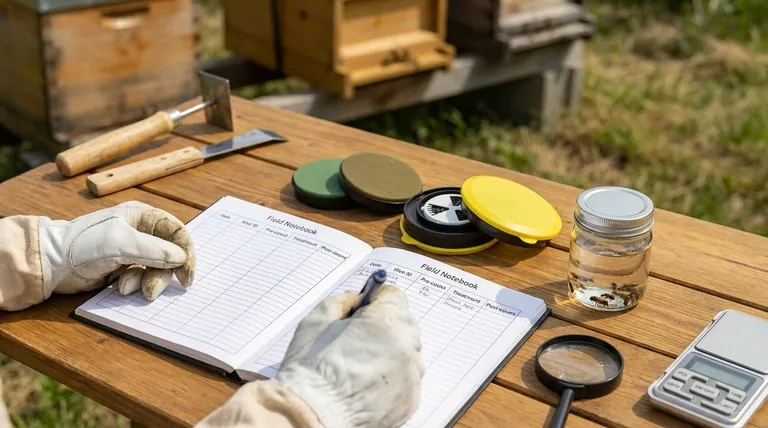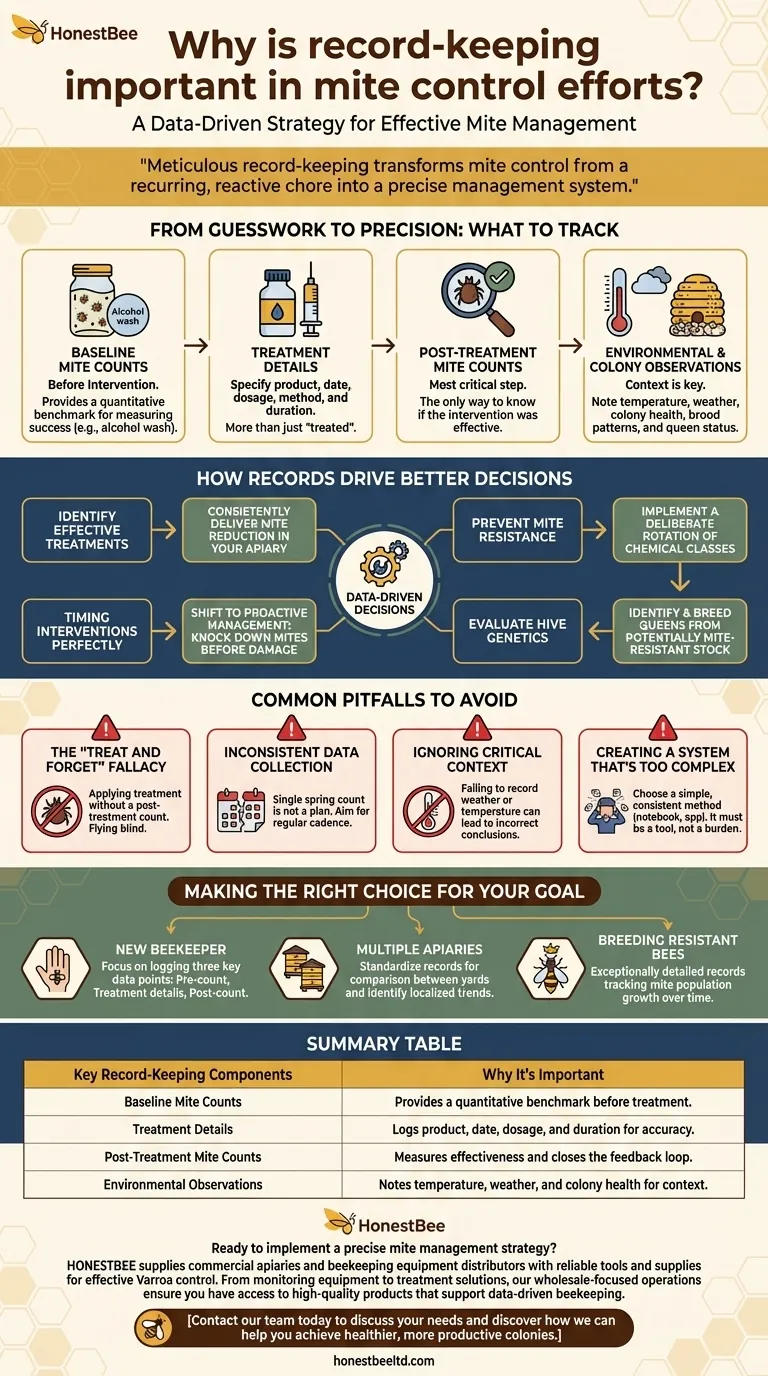Effective mite management is not a single action; it's a data-driven strategy. Proper record-keeping is the cornerstone of this strategy, allowing you to move beyond simply applying treatments and start making truly informed decisions. By tracking mite counts, treatment applications, and colony responses over time, you gain the critical feedback needed to understand what is—and is not—working for your specific hives.
Meticulous record-keeping transforms mite control from a recurring, reactive chore into a precise management system. It is the only way to objectively measure the success of your efforts and adapt your strategy for the long-term health of your colonies.

From Guesswork to Precision: What to Track
Effective records are more than just a date on a calendar. They are a detailed logbook of interventions and outcomes that, when reviewed, reveal patterns crucial for future success.
Baseline Mite Counts
Before any intervention, you must know your starting point. A pre-treatment mite count (e.g., from an alcohol wash or powdered sugar roll) provides a quantitative benchmark against which you can measure success.
Treatment Details
Simply writing "treated for mites" is insufficient. Your records must include the specific product used, the date of application, the dosage or method (e.g., number of strips), and the duration of the treatment period.
Post-Treatment Mite Counts
This is the most frequently missed, yet most critical, step. A follow-up mite count after the treatment is complete is the only way to know if the intervention was effective. It closes the feedback loop and validates your efforts.
Environmental and Colony Observations
Context is key. Note the temperature and weather during treatment, as many methods have strict temperature requirements for efficacy and safety. Also, observe colony health, brood patterns, and queen status before and after treatment to assess any negative impacts.
How Records Drive Better Decisions
Data collection is pointless without analysis. Your records become a powerful strategic tool that directly informs how you manage Varroa mites year after year.
Identifying Effective Treatments
Your records will clearly show which treatments consistently deliver the best mite reduction in your apiary. A product that works wonders for a beekeeper in another region might be ineffective for you due to local conditions or mite resistance.
Preventing Mite Resistance
Varroa mites can develop resistance if the same chemical treatment is used repeatedly. By tracking which treatments you use and their effectiveness, you can implement a deliberate rotation of different chemical classes, preserving their efficacy for years to come.
Timing Interventions Perfectly
After several seasons, your records will reveal when mite populations typically begin to rise in your area. This allows you to shift from reactive treatment of large infestations to proactive management, knocking down mites before they reach levels that damage the colony.
Evaluating Hive Genetics
Consistent records may highlight certain colonies that naturally maintain lower mite loads. This data is invaluable for identifying potentially mite-resistant genetics, allowing you to breed queens from your strongest and most resilient stock.
Common Pitfalls to Avoid
Even with good intentions, beekeepers can make mistakes in their record-keeping that undermine its value. Awareness of these pitfalls is the first step to avoiding them.
The "Treat and Forget" Fallacy
The most common error is applying a treatment and assuming the job is done. Without a post-treatment mite count, you are flying blind. You have no idea if the treatment worked, if the application was flawed, or if your mites are resistant.
Inconsistent Data Collection
Taking a single mite count in the spring is not a management plan. The value of records comes from consistent, comparable data points throughout the season. Aim for a regular cadence of monitoring.
Ignoring Critical Context
A treatment might fail not because the product is poor, but because it was applied when it was too hot or too cold. Failing to record environmental conditions leads to incorrect conclusions about a treatment's effectiveness.
Creating a System That's Too Complex
Your record-keeping system must be a tool, not a burden. Whether using a notebook, a spreadsheet, or a dedicated app, choose a method that is simple enough that you will use it consistently.
Making the Right Choice for Your Goal
Your approach to record-keeping should align with your beekeeping objectives. The goal is to create a system that serves your specific needs.
- If you are a new beekeeper: Focus on consistently logging three data points: the pre-treatment mite count, the treatment details (product and date), and the post-treatment mite count.
- If you are managing multiple apiaries: Standardize your record-keeping to enable easy comparison between yards, helping you identify localized mite pressure and treatment efficacy trends.
- If your goal is to breed mite-resistant bees: Your records must be exceptionally detailed, tracking mite population growth over time to identify colonies that effectively manage Varroa with minimal or no intervention.
Ultimately, your records are the most powerful tool you have for ensuring the long-term health and survival of your colonies.
Summary Table:
| Key Record-Keeping Components | Why It's Important |
|---|---|
| Baseline Mite Counts | Provides a quantitative benchmark before treatment. |
| Treatment Details | Logs product, date, dosage, and duration for accuracy. |
| Post-Treatment Mite Counts | Measures effectiveness and closes the feedback loop. |
| Environmental Observations | Notes temperature, weather, and colony health for context. |
Ready to implement a precise mite management strategy? HONESTBEE supplies commercial apiaries and beekeeping equipment distributors with the reliable tools and supplies needed for effective Varroa control. From monitoring equipment to treatment solutions, our wholesale-focused operations ensure you have access to high-quality products that support data-driven beekeeping. Contact our team today to discuss your needs and discover how we can help you achieve healthier, more productive colonies.
Visual Guide

Related Products
- Adjustable Formic and Acetic Acid Dispenser for Bee Mite Treatment
- Varroa Easy Check Mite Tester Kit Counter Alcohol Wash Jar
- Economy Galvanized Beekeeping Honey Bee Smoker for Wholesale
- Professional Bee Smoker with Elongated Spout and Durable Bellows for Beekeeping
- Wooden Queen Bee Excluder for Beekeeping
People Also Ask
- How do Varroa mites spread between honey bee colonies? Stop Mite Transmission in Your Apiary
- What is the optimal time for varroa mite control in nucs? Maximize Efficacy with Perfect Timing
- What is the focus of hive management during summer? Maximize Your Honey Harvest with Expert Tips
- How can beekeepers ensure their hives survive the winter? A Guide to Colony Survival
- What does Chewed Down Brood (CDB) indicate in bee colonies? A Sign of Varroa Mite Infestation



















